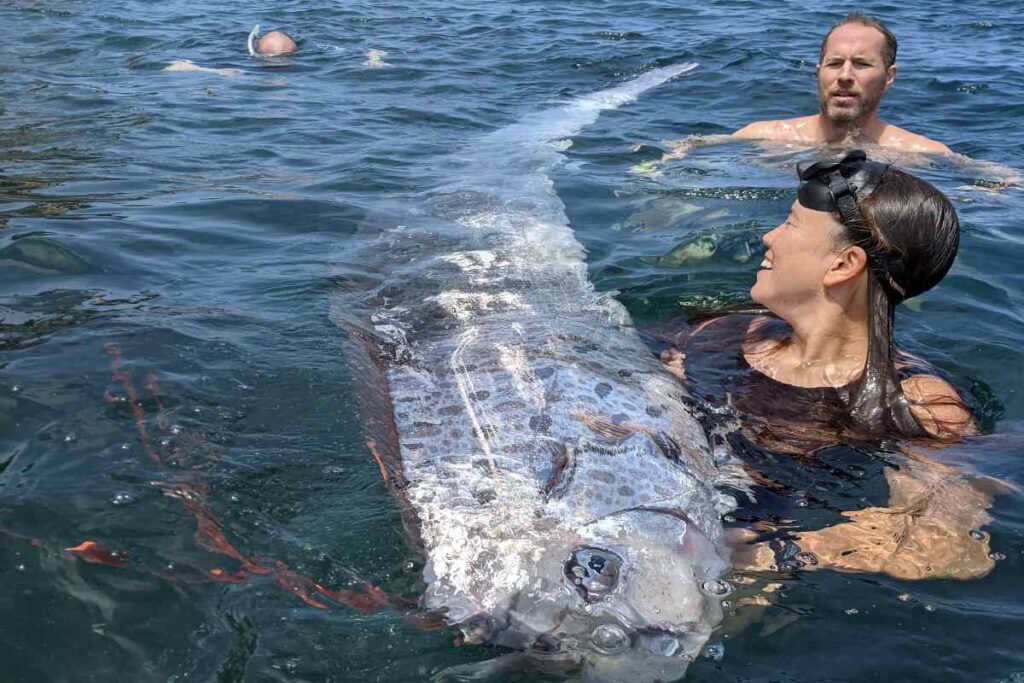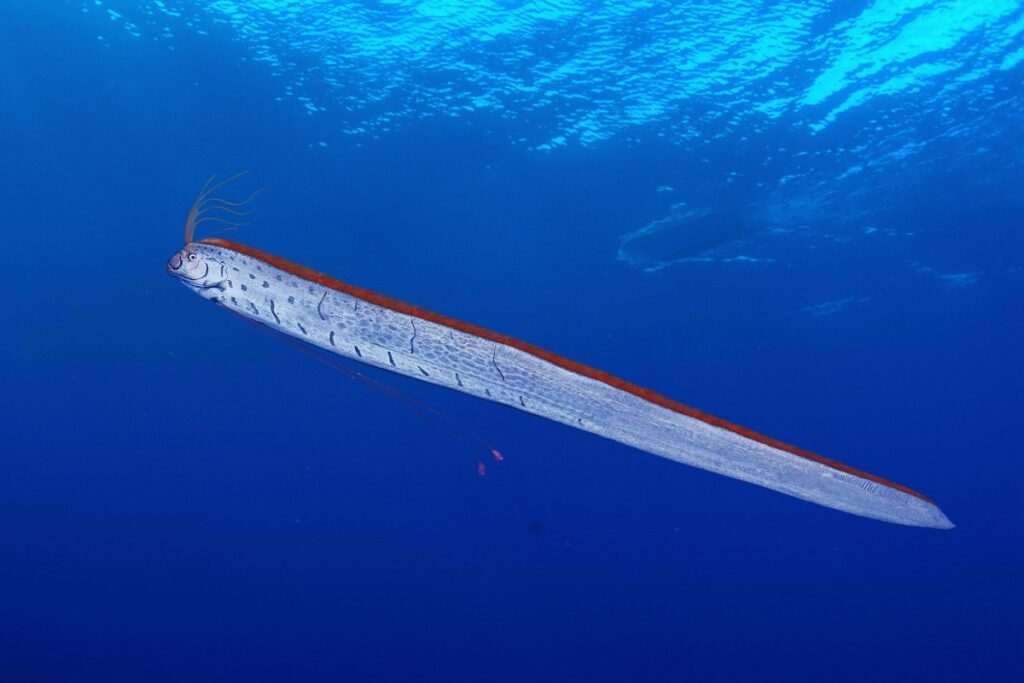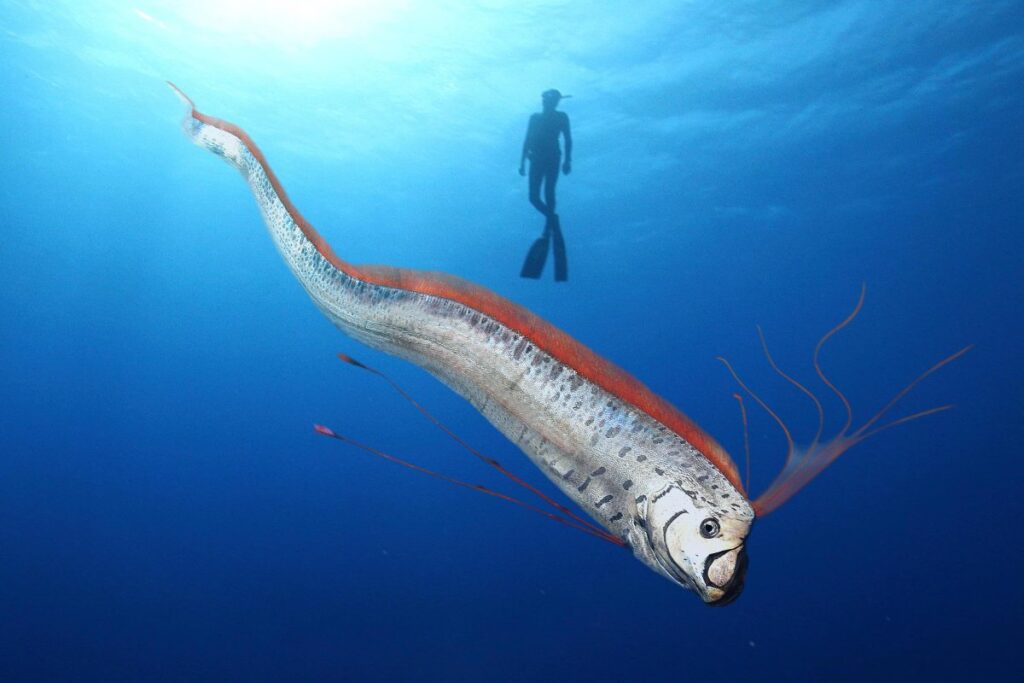
A new discovery off the coast of Southern California has left a group of kayakers and snorkelers shocked. The discovery that left audiences stunned was the finding of an extremely rare deep-sea fish popularly known as a “doomsday fish.”
Certain marine creatures in our oceans are incredibly large or strange, potentially inspiring ancient sea monster legends. Regalecus glesne, the enormous oarfish, is a prime illustration of this. The abnormally long, ribbon-shaped body of this remarkably huge and strange-looking fish allows it to float stealthily through the water column
A Rare Discovery
On Saturday, August 10, 2024, while exploring La Jolla Cove in California, the group discovered a 12-foot oarfish. The discovery was first reported by the Scripps Institution of Oceanography, which took to its Facebook page to share images of the fish.
On their Facebook page, Scripps said, “With help from NOAA Fisheries Service and California Sea Grant team members, the group was able to coordinate with lifeguards to transport the fish to the NOAA facility. Scientists from NOAA Southwest Fisheries Science Center and Scripps Oceanography will perform a necropsy to see if they can determine a cause of death.”
ALSO READ: Wife Makes Horrifying Discovery About Her Husband After Looking Through His iCloud
After the autopsy, the oarfish will be sent to the Marine Vertebrate Collection, where it will be further studied. According to the Institute, the oarfish, which had passed away at the time of the discovery, is one of 20 that have been seen on California shore since 1901.

What Is an Oarfish?
According to the Ocean Conservancy, the oarfish is a large, odd-looking fish with a distinctly long, ribbon-shaped body. However, its weird-looking body isn’t just for looks but to assist its floating in the water. In addition to its ribbon-shaped body, the oarfish also possesses a very big set of eyes along with a red spine.
The oarfish’s spine sticks out in a way that forms a crown-like cluster. Known for its size, an oarfish can grow as large as possible, reaching up to 30 feet in length. Despite their large size, the oarfish have a very small mouth, making them filter feeders with a diet consisting primarily of krill, plankton, and small crustaceans.

Why Is Oarfish Called Doomsday?
The oarfish is known by its alias, the doomsday fish, but how did it come to be known as such? The name comes from Japanese folklore, where an oarfish sighting is associated with disasters or destruction.
POLL—Should the U.S. Government Create a Path to Citizenship for Undocumented Immigrants?
Speaking on the infamous nickname, the Scripps Conservancy said, “The legend is that if you see an oarfish, it is a warning sign from higher powers that disasters such as earthquakes are soon to occur.”
According to the report, 20 oarfish were found dead ashore before Japan’s historic 2011 earthquake. Subsequently, on Monday, August 12, 2024, two days after the oarfish was discovered, a 4.4 earthquake hit Los Angeles.
This is because oarfish primarily reside in the mesopelagic zone, where light cannot reach them, making their sight extremely rare. The mesopelagic zone is 1000 meters above sea level and is closer to tectonic activities. So, whenever an oarfish is seen on the surface, it usually means it is sick, dying, or disoriented.

Are Oarfish Harmless?
Despite their large appearance, oarfish are very harmless, as they have small mouths and no teeth. Consequently, they eat by swimming with their mouths open, filtering small prey along the way. Their mouths contain modified bones, which support their gills and aid in capturing food.
WATCH: Lifestyle Hacks, Summer Foods and Diet Tips to Beat the Heat This Summer
It is important to remember that little is known about their behavior and state of conservation. Despite their habitat being one of the least-explored ocean regions, we must still safeguard them.
Scientists uncover new insights daily on plastic pollution’s destructive impact on marine ecosystems, including the deep sea. Even if we may not fully understand all of this issue’s ramifications just yet, it is abundantly evident that we must act.
You Might Also Like:
Naomi Osaka Shuts Down Pregnancy Rumors, Says ‘Giving Birth Was Traumatic’
Ellen DeGeneres and Portia de Rossi Celebrate 16 Years Together
Bear Attack Survival Guide: What To Do and How To Prevent It
Stay Cool and Fresh With These 5 Summer Hygiene Tips From Skin Experts
